Abstract
Lightning represents a critical danger to facilities such as oil tank farms, with the potential to cause major explosive incidents. To address this risk, Indonesia’s oil and gas industry has adopted the NFPA 780 Standard for lightning protection systems. However, tank explosions and refinery disruptions caused by lightning strikes continue to occur annually, highlighting the need to reassess the standard’s self-protection criteria, particularly in Indonesia’s tropical climate. The NFPA 780 standard was primarily developed based on lightning characteristics in subtropical regions. This study evaluates its effectiveness in tropical environments, where lightning parameters such as peak currents, frequencies, and ground flash densities differ significantly. By analyzing specific incidents of tank explosions in Indonesia, the research reveals that compliance with the NFPA 780 standard alone may not be adequate to protect critical infrastructure. To address these challenges, this study proposes a novel approach to lightning protection by designing solutions tailored to the unique characteristics of tropical climates. By incorporating local lightning parameters, the proposed measures aim to enhance safety and resilience in oil and gas facilities. This research provides a framework for adapting international standards to regional needs, improving the effectiveness of lightning protection in tropical environments.
1. Introduction
Indonesia is subjected to persistent high temperatures throughout the year due to its tropical position. As an archipelagic nation situated within the maritime continent, it contributes significantly to the production of sea salt aerosols. The country’s climate is marked by high humidity and abundant natural features such as dense forests, rivers, and lakes, which collectively create ideal conditions for the formation of cumulonimbus (CB) clouds. These conditions result in a notably high incidence of lightning activity across the region. To mitigate lightning-related hazards, Indonesia’s refineries commonly implement lightning protection measures based on internationally recognized standards, including NFPA 780 [1], API 650 [2], and API 2003 [3]. Under the NFPA 780 guidelines, any metal storage tank with a wall thickness of at least 4.8 mm is deemed to possess inherent resistance to direct lightning strikes, eliminating the need for supplementary lightning protection systems [4].
Despite adherence to established standards, oil tank failure statistics indicate a troubling pattern [5,6]. In Indonesia, lightning has been responsible for tank fires almost every year between 1995 and 2021. This ongoing problem is closely linked to Indonesia’s distinct tropical climate, where lightning behavior differs markedly from that in subtropical regions. However, international standards such as NFPA and API were primarily developed based on conditions typical of subtropical environments. This discrepancy raises an important concern: Are the NFPA and API standards truly adequate for safeguarding oil tanks against lightning strikes in tropical regions like Indonesia?
Globally, lightning remains a leading cause of equipment damage [7,8,9], fatalities [10,11,12,13,14,15,16], electrical system disturbance [17,18,19,20,21], and fires [22,23], especially in oil and gas infrastructure, which are particularly susceptible due to the flammable nature of the stored materials. Therefore, the findings and solutions proposed in this research are not only relevant for Indonesia, but may also benefit other tropical and equatorial regions facing similar challenges.
Mitigating the risks posed by lightning strikes [24,25,26] requires the design and installation of a well-structured lightning protection system, supported by a solid understanding of lightning behavior [27,28]. The system must be specifically designed to reflect the local lightning conditions and parameters relevant to the area it aims to protect. In other words, creating an effective lightning protection strategy depends on accurately identifying and addressing the unique lightning characteristics of the region. By adapting the system to these local conditions, its ability to reduce lightning-related hazards is greatly enhanced [29,30,31], offering better protection for infrastructure [32,33], equipment [34,35,36], and human safety against the destructive impact of lightning.
This paper aims to address the shortcomings of existing standards by exploring protection measures tailored to the tropical lightning profile found in Indonesia. Part II reviews related work and highlights key limitations of current lightning protection frameworks when applied in tropical settings. Part III details the methodology used to evaluate lightning parameters and analyze existing incidents. Part IV presents a targeted lightning protection system designed specifically for tropical environments, integrating localized data and advanced monitoring technology. Finally, Part V concludes with key insights and recommendations for enhancing lightning protection in the oil and gas industry.
2. Related Work
This section explains previous research related to this study. The lightning protection system of oil and gas tanks complies with NFPA 780/2011 standards. The NFPA 780/2011 standard states that tanks made of metal with a thickness of 4.8 mm are self-protected against the impact of direct lightning strikes and do not need additional protection. However, based on statistics, tanks in Indonesia catch fire and explode due to lightning strikes almost every year; in fact, since 1995, oil and gas tanks have been struck 31 times by lightning and caught fire. This is mainly because the characteristics of lightning in Indonesia are different from the characteristics of sub-tropical lightning [37,38,39,40,41], so that NFPA standards are not sufficient to overcome the dangerous impacts of tropical lightning. Almost all fuel tanks in Indonesia use the NFPA standard.
Significant disparities exist between lightning behavior in tropical and subtropical climates. Extensive investigations spanning eight years at the Lightning Research Station, Mount Tangkuban Perahu, have uncovered several unique attributes of tropical lightning. Among these, the electric charge transferred during a strike (Q) stands out as a pivotal parameter, particularly in shaping effective lightning protection measures within the oil and gas industry. Lightning in Indonesia is characterized by a long wave tail, resulting in a high charge parameter for the lightning current (Q = ∫ i. dt, measured in A.s or Coulombs), as illustrated in Figure 1. This high charge has a significant melting effect when metal is struck by a direct lightning strike. At the point of impact, sparks can form, leading to the melting of the metal and the formation of holes in fuel tanks, as depicted in Figure 2. Due to the large charge associated with tropical lightning, the resulting holes at the strike point are often larger. When fire triangle conditions are met, including the presence of oxygen, flammable material, and sparks, these factors can trigger explosions and fires in the fuel tanks. These findings underscore the need for tailored protection measures to address the risks posed by tropical lightning, beyond the limitations of existing international standards.
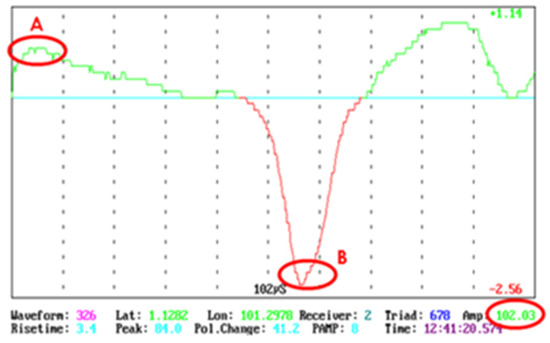
Figure 1.
Tropical lightning wave recorded by lightning position and tracking system. Notes: A. peak value of positive polarity; B. peak value of negative polarity; green line: positive polarity waveform; red line: negative polarity waveform.
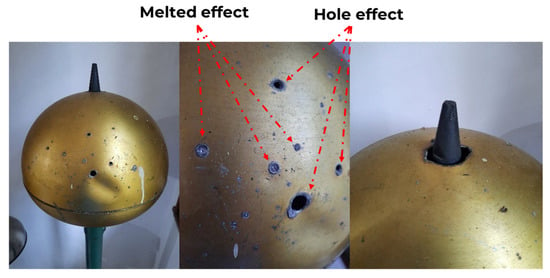
Figure 2.
Air terminal taken from the lightning research tower on Mount Tangkuban Perahu, West Java, Indonesia (May, 2021).
3. Methodology
This section will explain the methodology of this paper. Currently, international lightning protection standards, such as IEC, NFPA, IEEE, JIS, and NEMA, are primarily based on subtropical lightning characteristics, leading to a mismatch when applied in tropical regions. To address this gap, Indonesia is developing research fields and test sites, such as the Lightning Research Station at Mount Tangkuban Perahu (SPP-TP) and in Bogor (SPP-Bogor), to study and innovate tropical lightning protection systems.
Existing protection requirements have been re-evaluated using local data—particularly lightning peak current, current charge, polarity, and strike frequency—to identify shortcomings in the self-protection criteria (e.g., the 4.8 mm tank thickness). This analysis highlights the need to supplement the NFPA 780 standard with additional protection measures, including extended mast terminals, shielded conductors, and advanced grounding systems.
The research also aims to produce innovations such as preventive external protection systems, shielded cabling, and monitoring technologies. These efforts are expected to contribute to standard enhancements through scientific publications, intellectual property (e.g., patents), and the development of more robust lightning protection systems tailored specifically for tropical conditions.
Based on the flowchart in Figure 3, the methodology for improving the NFPA 780 standard in the context of tropical lightning environments followed a structured and data-driven approach. The process begins with the identification of the limitations of the existing NFPA 780 standard, particularly when applied to tropical conditions characterized by high lightning frequency, large current charges (Q), steep waveform slopes, and long wave tails. To address this, local lightning data, including peak current, charge, flash density, and the steepness of current rise are collected from field observations and measurement systems.
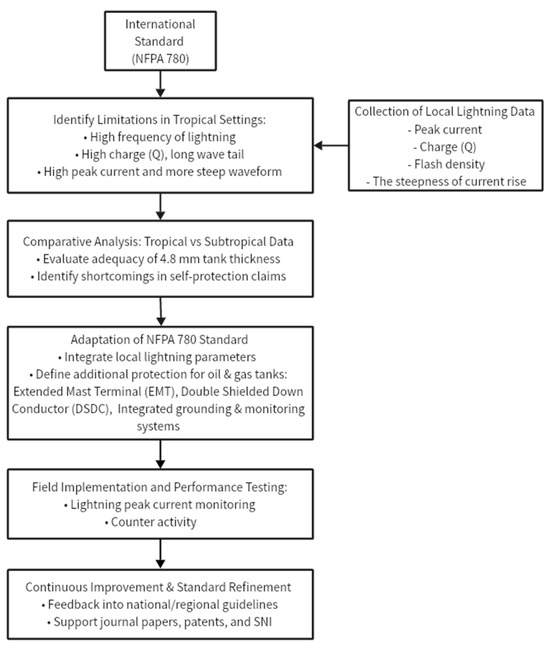
Figure 3.
Improvement of standard framework in Indonesia.
These data are then used for comparative analysis between tropical and subtropical lightning characteristics. Through this analysis, the adequacy of the standard 4.8 mm tank wall thickness is re-evaluated, and potential shortcomings in the standard’s self-protection assumptions are identified.
The findings inform the adaptation of the NFPA 780 standard, integrating localized parameters and recommending additional protective measures for oil and gas infrastructure. These include the use of Extended Mast Terminals (EMTs), Double Shielded Down Conductors (DSDCs), and integrated grounding and lightning monitoring systems.
Following adaptation, the improvement in framework is tested in real-world environments through field implementations in locations like Cilacap (Central Java), Balongan (West Java), and Plaju (South Sumatera). During these trials, data such as lightning peak currents and counter activities are continuously monitored to assess performance.
Finally, insights gained from testing are used for continuous improvement and refinement of the standards. The feedback loop contributes to the development of updated national or regional guidelines and supports scientific outputs in the form of publications, patents, and proposed revisions to SNI (Indonesian National Standard). This methodology ensures that lightning protection systems are not only technically sound but also regionally relevant.
4. Result and Discussion
In this section, a comprehensive analysis of lightning accidents in Indonesia is presented. The findings are based on extensive evaluations conducted across several regions, with particular emphasis on areas of high lightning density and vulnerable infrastructure. Key insights into the performance and effectiveness of preventive lightning protection systems are discussed, alongside the identification of regions requiring further attention. By interpreting the results, this section aims to provide a deeper understanding of lightning activity in Indonesia and its implications for infrastructure resilience and safety.
4.1. Analysis of Lightning Fire Mechanisms in Indonesia
4.1.1. Lightning Impact on Floating Roof Tank Leads to Fire in Another Unit in Sangasanga, East Kalimantan
As part of the protective design for an oil storage tank, a calculated installation of two 22 m high lightning masts was carried out. These structures were deliberately positioned on opposite sides of the tank to ensure optimal coverage, as depicted in Figure 4.
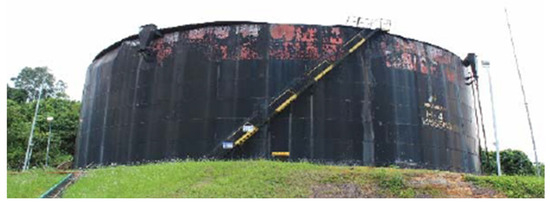
Figure 4.
Incident of lightning hitting a floating roof tank—Sangasanga, East Kalimantan.
The primary objective of these masts was to defend against the lightning threat identified. Despite the addition of lightning protection components, the tank was still struck, revealing a critical flaw in the system’s installation. This incident underscores the vital importance of proper design, installation, and ongoing maintenance of lightning protection systems, to effectively reduce such risks.
After the lightning strike, the lightning current charge (Q) emerged as a crucial factor. This parameter can significantly impact a tank’s structure, potentially leading to the formation of holes. Such damage compromises the tank’s structural integrity and raises the risk of oil leaks or other dangerous outcomes.
Furthermore, the tanks are exposed to the risk of explosion due to the conditions described by the fire triangle—oxygen, a source of ignition, and flammable material. In this context, the heat from the lightning strike can act as the ignition source, particularly when flammable vapors or substances are present. When all three elements converge, the likelihood of an explosion becomes a serious hazard.
In conclusion, the combination of elevated lightning risk, potential structural failure due to high charge current, and fire or explosion threats presents a complex challenge for oil storage safety. Effectively managing this situation requires a comprehensive strategy that includes not only the proper installation of lightning protection systems but also rigorous safety protocols to mitigate the consequences of lightning-related incidents.
4.1.2. Internal Floating Roof Tank Ignited by Indirect Lightning Strike in Cilacap, Central Java
A lightning induction occurred when lightning hit an object or area away from an oil storage tank which is located approximately 460 m from the strike point, as illustrated in Figure 5. Although the tank was not directly struck, the lightning had serious and unexpected consequences. The distant strike generated a sudden and significant voltage difference near the tank’s floating roof seal. This phenomenon was most likely triggered by a lightning electromagnetic pulse (LEMP), capable of inducing transient currents and voltages in adjacent conductive objects, such as the tank structure.
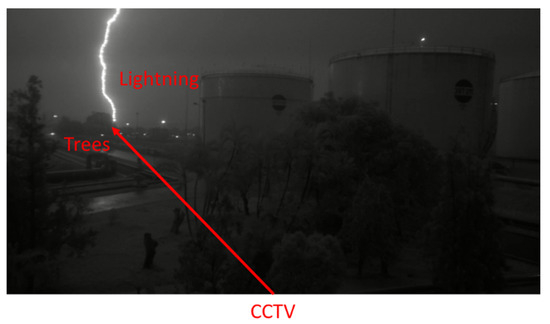
Figure 5.
Indirect lightning strike near the tank area in Cilacap, Central Java.
The voltage imbalance led to the formation of a spark at the seal of the floating roof. This arc, resulting from a sudden discharge due to the differential in induced electrical potential when the lightning strike happened, generated a highly concentrated and intense burst of heat in a confined area. In this case, the spark served as the ignition point, ultimately triggering a fire. This incident likely occurred as illustrated in Figure 6, which appears to capture the onset and progression of the blaze.
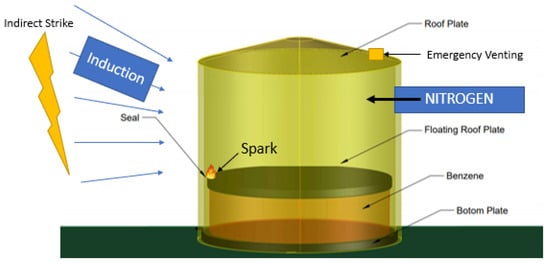
Figure 6.
Spark mechanisms in Cilacap tank fire.
This incident highlighted the potentially dangerous effects of indirect lightning strikes, even when they occur at a considerable distance. It demonstrated how induced voltage from a remote strike can generate sparks that ignite flammable materials, in this case, leading to a fire outbreak at the oil tank’s floating roof seal.
Figure 7 shows an indirect lightning strike in Cilacap that resulted in a series of incidents, leading to explosions at an oil storage facility. The lightning did not directly hit the tank but created an ignition point outside the tank, likely due to the discharge of energy. As a result, one of the storage tanks (tank A) experienced an explosion from within, causing the roof plate and emergency venting system to be thrown off due to the sudden pressure release. This was followed by a fire ignition point outside tank B. Despite the explosion, the surrounding tanks remained intact, highlighting the localized impact of the incident. The fire ignition outside the tank suggests that flammable vapors or leaks in the vicinity could have contributed to the explosion. This situation illustrates why resilient lightning protection systems are essential to minimize the risks of indirect lightning strikes, particularly in facilities storing flammable materials.
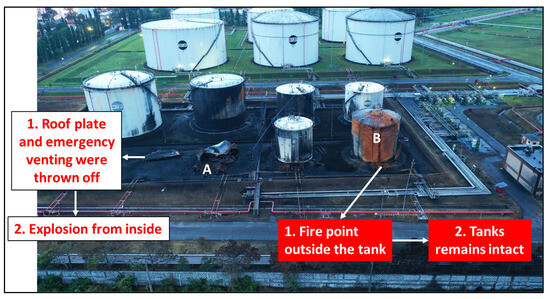
Figure 7.
The impact of an indirect lightning strike to the tanks.
Gaining insight into these incidents is vital for strengthening safety protocols and lightning protection systems in critical industrial environments, especially at oil storage facilities. It emphasizes the need for a holistic approach, one that addresses not only direct lightning strikes but also the indirect effects, such as the generation of electrical sparks and the risk of fire.
4.1.3. Floating Roof Tank Hit by Lightning, Leading to Multiple Tank Explosions in Balongan, West Java
A fully filled storage tank sustained a direct lightning strike, delivering an extreme surge of energy that led to intense heat buildup and partial melting of the tank’s exterior surface. Despite this thermal damage, the strike did not breach the tank’s wall or create any openings. Consequently, although the tank’s structural resilience was compromised, it remained intact, with no release of combustible substances.
This outcome is particularly significant in the context of the “fire triangle”—a foundational fire safety model comprising three essential components: an ignition source, oxygen, and flammable material. For combustion to occur, all three must be simultaneously present. In this situation, while the lightning provided an ignition source and atmospheric oxygen was available, the absence of leaked fuel or vapors prevented the fire triangle from forming. Therefore, under these specific conditions, the potential for ignition was effectively eliminated.
However, the situation does not end there. The lightning strike and the resulting melting of the tank wall may have compromised the tank’s structural integrity. In this weakened state, the internal pressure from the oil or other stored substances may cause a leakage. In other words, the damaged tank could begin to release its contents due to the internal pressure.
The danger escalated significantly when flammable substances began to leak. When this leaked material was later exposed to another lightning strike, it served as the missing fuel element needed to complete the fire triangle. Given the high energy carried by lightning, a secondary strike could easily ignite a spark upon contact with the leaked substance. This spark, when combined with the presence of oxygen in the atmosphere and the flammable material on the ground, created ideal conditions for ignition, leading to a fire.
To summarize, although the initial lightning strike on the fully sealed tank did not immediately result in fire, since the tank wall remained unpunctured, it initiated a chain reaction. The structural compromise caused by the strike eventually led to the release of flammable liquids. When the next lightning event occurred, it provided the necessary ignition source, fulfilling all the conditions required for combustion under the fire triangle model.
This chain of events underscores the necessity for robust and all-encompassing lightning protection and fire prevention strategies in facilities that store combustible materials. It also illustrates the complex and sometimes delayed nature of fire incidents, where the danger may not be evident until secondary events occur.
Refinery installations, particularly those with tanks situated in open, elevated areas, are highly vulnerable to lightning activity. Floating roof tanks, in particular, are at risk of experiencing direct strikes that can cause physical damage such as melting of the shell or surges in electrical potential within systems like the Automatic Tank Gauging (ATG). These surges create a voltage differential between the tank’s outer wall and the floating roof, increasing the likelihood of spark generation. Even nearby lightning strikes, without direct contact, can induce electrical voltages in these tanks, further raising the risk of internal arcing and ignition.
Fixed roof tanks are also susceptible. Lightning can impact various structural components, such as the roof tank, wall, ATG system, or breather valve. A strike on any of these parts may melt metal surfaces or components, potentially releasing vaporized fuel. Combined with ambient oxygen and the heat from the strike, this can easily result in a fire. In each case, voltage spikes caused by the lightning can lead to electrical discharge at points where voltage levels vary, creating ignition sources that threaten the safety of the facility.
4.2. Lightning Protection System Policy in Indonesia
As previously mentioned, the Indonesian oil and gas sector is exposed to considerable risks stemming from the unique characteristics of tropical lightning, which differ markedly from those found in subtropical regions. Figure 8 highlights a comprehensive framework for tropical lightning research, focusing on the implications for standards, infrastructure, and innovation in Indonesia. Tropical lightning, with its distinct frequency, intensity, and polarity, presents unique challenges for infrastructure, including sectors such as electricity (PLN), railways (KAI), defense (Hankam), oil and gas, telecommunications, airports, and buildings. These challenges necessitate protection systems tailored to tropical environments.
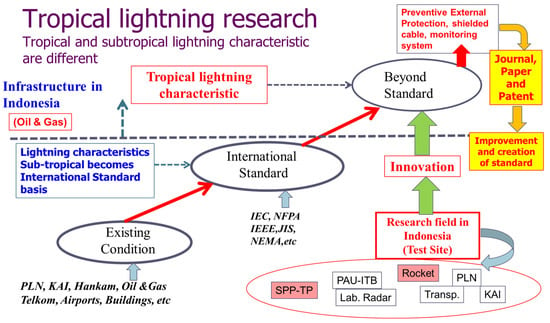
Figure 8.
Lightning protection policy in Indonesia.
While international lightning protection standards primarily address the characteristics of subtropical lightning, tropical lightning exhibits notably different features, such as higher peak currents, steeper waveforms, and longer durations.
Despite their global recognition, international lightning protection standards—such as those developed by the NFPA and API—have proven insufficient in preventing fires caused by lightning strikes on storage tanks. This conclusion is reinforced by documented incidents in Indonesia spanning from 1995 to 2023. Standard protective methods like grounding and bonding, although widely practiced, exhibit inherent limitations in deterring direct lightning strikes and alleviating the mechanical stress inflicted on tank structures. Due to their passive functionality, bonding systems cannot actively intercept or neutralize lightning, leaving storage tanks vulnerable to direct impact.
Indonesia’s lightning protection policies face challenges in adopting international standards such as IEC, NFPA, JIS, and NEMA, as these frameworks are primarily based on subtropical lightning behavior. Tropical lightning occurs more frequently due to the high temperatures and intense humidity in tropical regions. Studies have shown that lightning in tropical areas, including Indonesia, often has lower peak currents compared to lightning in subtropical regions. Additionally, tropical lightning is often dominated by negative polarity, which has a direct impact on the design of lightning protection systems.
To ensure the effectiveness of lightning protection systems in Indonesia, there is an urgent need for more specific research and development on tropical lightning characteristics. This includes adjusting international standards to align with tropical conditions and developing national standards based on local data, while adhering to the general principles of international standards.
4.3. Extended Mast Terminal (EMT)
The Extended Mast Terminal (EMT) has been introduced as a modern solution for mitigating lightning-related hazards, particularly in industrial settings. This advanced system represents a significant development in lightning protection technology, designed to shield structures or equipment from direct lightning impacts. As illustrated in Figure 9, the EMT system integrates several key components, including an air terminal, a mast made from Fiber Reinforced Plastic (FRP), a specialized Double Shielded Down Conductor (DSDC), and a monitoring panel equipped with a Lightning Event Counter (LEC) and a Magnetic Tape Measuring Instrument, all linked to an integrated grounding system. Together, these components function to minimize the risk of fires caused by lightning strikes on critical infrastructure such as storage tanks.
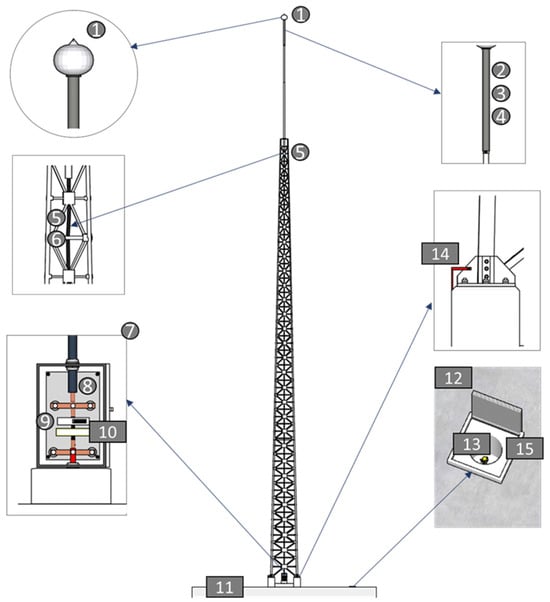
Figure 9.
Preventive lightning protection system. Notes: 1. Air Terminal; 2. Fibre/FRP; 3. Squeezing Fibers; 4. Sealing End/Upper Termination; 5. Shielded Cable 1 × 70 mm2; 6. Clamp cable; 7. Monitoring Box; 8. Lower Termination; 9. Lightning Event Counter (LEC); 10. Magnetic Tape; 11. Integrated Grounding System; 12. Grounding Box; 13. Grounding Rod; 14. Grounding connection to the base of the tower; 15. Connection to existing grounding systems.
The air terminal plays a critical role by increasing the probability that any lightning discharge will strike the protection system rather than nearby structures or vulnerable assets. When paired with the FRP mast and DSDC cable, the air terminal ensures that the electrical energy from the lightning is safely captured and redirected away from protected structures.
The DSDC cable is a highly engineered down conductor designed specifically to mitigate voltage surges associated with lightning currents. Owing to its exceptionally low inductance (0.026 H/m), the DSDC is capable of significantly reducing transient voltages during a strike. It also possesses a lower surge impedance compared to conventional cables, which enhances its effectiveness. A key feature of the DSDC is its shielding, which minimizes electromagnetic interference with adjacent structures and mitigates the risk of side-flash events.
Engineered for optimal performance, the DSDC cable consists of several alternating conductive and insulating layers. At its core is a plastic fiber center, surrounded by a copper conductor. This is followed by a primary insulation layer, a conductive copper sheet for additional shielding, secondary insulation, and an external protective layer. This multi-layered construction enables the DSDC cable to safely conduct high-energy lightning currents, while maintaining electrical isolation and minimizing induced effects on nearby components.
To measure both the lightning peak current and the frequency of lightning strikes, the current isolated by the DSDC down conductor can be utilized. The lightning monitoring system consists of two key instruments: a Lightning Event Counter (LEC) and a Magnetic Tape Measuring Instrument. The LEC functions as a recording device that tracks the number of lightning strikes occurring over time. The practical application of this lightning protection system is shown in Figure 10 and Figure 11, which illustrate installations in Plaju (South Sumatra) and Gresik (East Java).
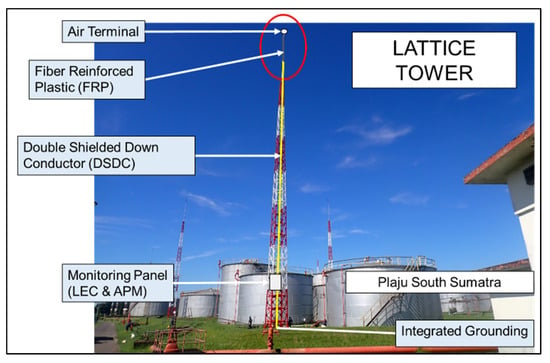
Figure 10.
Implementation of preventive lightning protection system in South Sumatra.
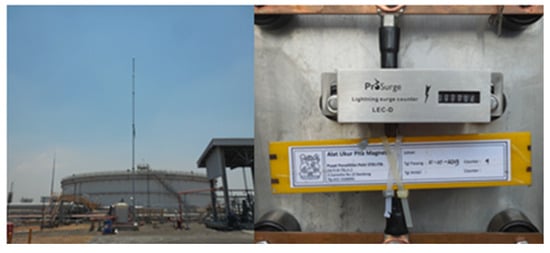
Figure 11.
Implementation of preventive lightning protection system in Gresik, East Java.
The air terminal used in this system has undergone testing since 1995 at Mount Tangkuban Perahu, located in Bandung, West Java. The testing involves two identical towers (Tower-1 and Tower-2), each standing 30 m tall, and is conducted to verify the performance and reliability of the air terminal in intercepting lightning. The design and operation of external lightning protection systems, including this air terminal, are referenced in international standards from France, Spain, and Portugal, as well as Indonesia’s national standard (SNI).
4.4. Evaluation of Extended Mast Terminal System’s Performance
The primary goal of this evaluation is to assess the effectiveness of preventive lightning protection systems in reducing infrastructure damage, identify vulnerable areas requiring additional protective measures, and provide a foundation for improving existing systems. By visualizing these data, stakeholders can better prioritize regions for enhanced protection strategies, particularly in areas with high lightning activity or inadequate protective infrastructure.
In this study, the primary instrument to evaluate the lightning protection performance is magnetic tape [42]. This device is complemented by a lightning event counter, which is used to keep an accurate count of the number of lightning strikes. The use of these instruments allows for the comprehensive collection of peak current data from numerous lightning events. By gathering a larger volume of data, the study aims to produce statistical analyses that are both highly accurate and precise. This meticulous data collection and analysis are crucial for understanding the characteristics of lightning currents and improving the effectiveness of lightning protection measures.
The evaluation of preventive external lightning protection in Indonesia is depicted through two maps, as shown in Figure 12.
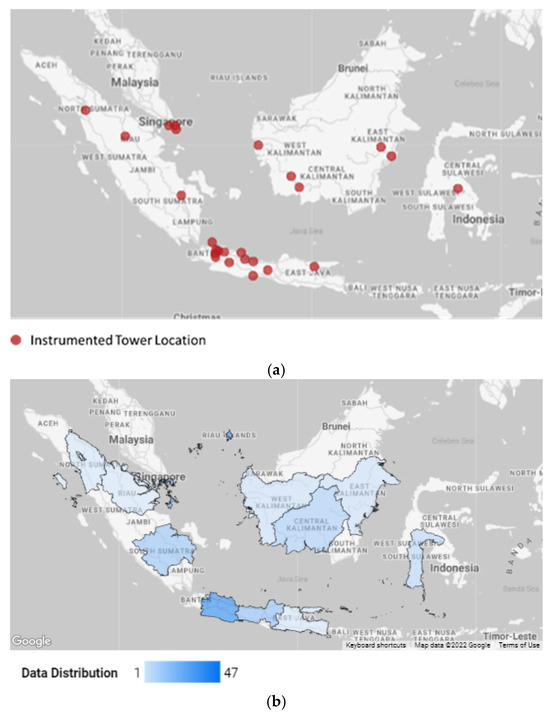
Figure 12.
Evaluation of preventive external protection in several locations of Indonesia: (a) installation of EMT in Indonesia, (b) the number of lightning strikes in EMT without negative damage.
The map on the left shows specific assessment locations, represented by red dots, with evaluations starting in 2005. These locations are primarily concentrated in regions such as Sumatra, Java, Kalimantan, and Sulawesi, suggesting a focus on areas with high infrastructure density or critical assets. The map on the right illustrates the distribution of evaluation data using a gradient blue scale, where darker shades indicate higher data coverage and lighter shades signify lower coverage. Regions such as Java and Kalimantan demonstrate more extensive evaluations, reflecting greater attention being given to these areas. In contrast, parts of Eastern Indonesia display a limited data distribution, indicating fewer critical sites or assessments.
Based on Table 1, the lightning protection performance against direct lightning strikes appears to be functioning effectively across the three locations of Cilacap, Balongan, and Plaju, as evidenced by the limited increase in counter readings despite exposure to high peak currents.

Table 1.
Lightning protection performance against direct lightning strikes.
In Cilacap, several peak current values exceeded 30 kA, such as 54.3 kA, 122.8 kA, and 35.4 kA, and this indicates that the protection system is successfully intercepting and safely discharging high-energy lightning events, suggesting proper grounding and capture efficiency. Similarly, in Balongan, the protection system also responded well to strikes with significant peak currents, including 28.5 kA and 119.05 kA. For instance, on 1 May 2024, despite a very high peak current of 119.05 kA, the counter only increased by 1, indicating a successful single-event protection, with no signs of system stress or failure. At Plaju, the system has also shown stability. For example, on 5 Jan 2025, a strong strike with a peak current of 86.6 kA was recorded. Other events also show moderate currents (e.g., 8.17 kA and 9.27 kA), with minimal counter changes, further confirming the protection system’s effectiveness.
Overall, the small increments in the counter values, even in the presence of very high peak current lightning strikes, demonstrate that the installed lightning protection systems are functioning well and are capable of mitigating direct lightning strikes efficiently in these critical locations.
5. Conclusions
Lightning damage to oil and gas installations remains a significant concern in Indonesia, highlighting the limitations of the NFPA 780 Standard in addressing the unique challenges posed by tropical lightning. To tackle this issue, advanced external lightning protection technologies have been introduced. This system offers an innovative solution, designed to prevent lightning strikes on structures by incorporating an air terminal, Fiber Reinforced Plastic (FRP) support, Double Shielded Down Conductor (DSDC), and a monitoring system that includes a Lightning Event Counter (LEC), Magnetic Tape Measuring Instrument, and an integrated grounding system to reduce the risk of fires in storage tanks due to lightning current conduction.
These technologies were specifically developed to overcome the deficiencies of conventional protection methods, especially in areas with high lightning density. Evaluations conducted at multiple sites across Indonesia have demonstrated their effectiveness in mitigating lightning-related hazards. To improve the safety and resilience of critical infrastructure, the continued adoption and development of these protection systems is essential.
Author Contributions
In this research activity, all the authors were involved in the data collection and preprocessing phase, result analysis and discussion, and manuscript preparation. All authors have read and agreed to the published version of the manuscript.
Funding
This research received no external funding.
Data Availability Statement
The data are available in the article.
Acknowledgments
The author would like to acknowledge the financial support received from Institut Teknologi Bandung, Indonesia.
Conflicts of Interest
The authors declare no conflicts of interest.
References
- NFPA 780/2020; Standard for the Installation of Lightning Protection System 2020. Technical Committee on Lightning Protection: Quincy, MA, USA, 2020.
- API 650; Welded Steel Tanks for Oil Storage 2007. American Petroleum Institute: Washington, DC, USA, 2007.
- API 2003; Protection Against Ignitions Arising Out of Static, Lightning, and Stray Currents 1998. American Petroleum Institute: Washington, DC, USA, 1998.
- Denov, B.; Zoro, R. Evaluation of NFPA 780 Standard for Lightning Protection of Oil and Gas Installation in Indonesia. In Proceedings of the 2023 International Symposium on Lightning Protection (XVII SIPDA), Suzhou, China, 9–13 October 2023. [Google Scholar]
- Liu, Y.; Fu, Z.; Jiang, A.; Liu, Q.; Liu, B. Analysis of the Effect on the Large Floating Roof Oil Tanks Struck by Indirect Lightning Based on FDTD. In Proceedings of the 2014 International Conference on Lightning Protection (ICLP), Shanghai, China, 11–18 October 2014; pp. 911–916. [Google Scholar]
- Yu, S.; Xu, W.; Qin, B. Study on Risk Assessment Method of Lightning Disaster About Petroleum in Chongqing. In Proceedings of the 2019 11th Asia-Pacific International Conference on Lightning (APL), Hong Kong, 12–14 June 2019; pp. 1–3. [Google Scholar]
- Cao, J.; Du, Y.; Ding, Y.; Li, Z.; Zhang, Y. Novel Evaluation of the Damage Rate of Surge Arresters Due to Lightning Stroke in a Distribution Network. In Proceedings of the 2022 36th International Conference on Lightning Protection (ICLP), Cape Town, South Africa, 2–7 October 2022; pp. 76–81. [Google Scholar]
- Ito, H.; Yokoyama, S.; Matsui, M.; Sato, T. Explosive Damages of Structures Due to Winter Lightning. In Proceedings of the 2022 36th International Conference on Lightning Protection (ICLP), Cape Town, South Africa, 2–7 October 2022; pp. 307–310. [Google Scholar]
- Liu, Y.; Fu, Z.; Gao, X.; Li, T.; Dai, M. Damage Characteristics and Response of Al Alloy 3003 to Different Components of Simulated Lightning Currents. IEEE Access 2018, 6, 1277–1283. [Google Scholar] [CrossRef]
- Ab Kadir, M.Z.A.; Misbah, N.R.; Gomes, C.; Jasni, J.; Wan Ahmad, W.F.; Hassan, M.K. Recent Statistics on Lightning Fatalities in Malaysia. In Proceedings of the 2012 International Conference on Lightning Protection (ICLP), Vienna, Austria, 2–7 September 2012; pp. 1–5. [Google Scholar]
- Navarrete-Aldana, N.; Cooper, M.A.; Holle, R.L. Lightning Fatalities in Colombia from 2000 to 2009. In Proceedings of the 2014 International Conference on Lightning Protection (ICLP), Shanghai, China, 11–18 October 2014; pp. 40–46. [Google Scholar]
- Srinivasan, V.; Fernando, M.; Kumara, S.; Selvaraj, T.; Cooray, V. Modeling and Assessment of Lightning Hazards to Humans in Heritage Monuments in India and Sri Lanka. IEEE Access 2020, 8, 228032–228048. [Google Scholar] [CrossRef]
- Holle, R.L.; Cramer, J.A.; Laing, A.; Thompson, E.G. Jamaica Lightning Occurrence, Damage, and Casualties. In Proceedings of the 2022 36th International Conference on Lightning Protection (ICLP), Cape Town, South Africa, 2–7 October 2022; pp. 1–5. [Google Scholar]
- Zhang, Y.; Zhang, W.; Meng, Q. Lightning Casualties and Damages in China from 1997 to 2010. In Proceedings of the 2012 International Conference on Lightning Protection (ICLP), Vienna, Austria, 2–7 September 2012; pp. 1–5. [Google Scholar]
- Koutras, K.; Kasfiki, E.; Pyrgioti, E. Statistical Analysis of Deaths and Damages Caused by Lightning Strikes in Greece. In Proceedings of the 2021 35th International Conference on Lightning Protection (ICLP) and XVI International Symposium on Lightning Protection (SIPDA), Colombo, Sri Lanka, 20–26 September 2021; pp. 1–5. [Google Scholar]
- Gomes, C.; Lubasi, F.C.; Gomes, A.; Doljinsuren, M. Concerns of the Application of Lightning Protection Risk Assesment for Small Structures. In Proceedings of the 2016 33rd International Conference on Lightning Protection (ICLP), Estoril, Portugal, 25–30 September 2016; pp. 1–5. [Google Scholar]
- Ain, N.U.; Mahmood, F.; Rizk, M.E.M. A Neural Network Based Prediction System for Lightning Induced Over-Voltages on Overhead Lines Considering the Soil Electrical Parameters. In Proceedings of the 2022 36th International Conference on Lightning Protection (ICLP), Cape Town, South Africa, 2–7 October 2022; pp. 99–104. [Google Scholar]
- Yun, M.; Zou, M. Study on Lightning Protection for Oil Transporting Station. In Proceedings of the 2011 7th International Conference on Wireless Communications, Networking and Mobile Computing, Wuhan, China, 23–25 September 2011; pp. 1–4. [Google Scholar]
- Hansen, A.N.; Erichsen, H.V.; Politis, Z.G. Lightning Protection of the Electrical Systems of WTG: Evaluation Considerations Related to the Application of SPDs. In Proceedings of the 2012 International Conference on Lightning Protection (ICLP), Vienna, Austria, 2–7 September 2012; pp. 1–6. [Google Scholar]
- Yamanaka, A.; Ishimoto, K.; Tatematsu, A. Direct Lightning Surge Analysis of Distribution Lines Considering LEMPs from Lightning Channel and Struck Pole in EMT Simulation. IEEE Trans. Electromagn. Compat. 2023, 65, 1909–1920. [Google Scholar] [CrossRef]
- Duan, P.; Zhang, L.; Huang, X.; Sun, J.; Qi, Y.; Yang, Q. Evaluation of Lightning-induced Overvoltage on a 10 kV Distribution Line Based on Electromagnetic Return-Stroke Model Using Finite-difference Time-domain. High. Voltage 2024, 9, 356–366. [Google Scholar] [CrossRef]
- Theng, J.; Denov, B.; Khayam, U.; Zoro, R. Design of Lightning Protection System for Oil and Gas Tanks Using 3-D Modeling Rolling Sphere Method. In Proceedings of the 2024 6th International Conference on Power Engineering and Renewable Energy (ICPERE), Bandung, Indonesia, 5–6 November 2024; pp. 1–6. [Google Scholar]
- Adekitan, A.; Rock, M. The Undesirable Interaction of Lightning Strike and Floating Roof Tanks. In Proceedings of the 2021 35th International Conference on Lightning Protection (ICLP) and XVI International Symposium on Lightning Protection (SIPDA), Colombo, Sri Lanka, 20–26 September 2021; pp. 1–8. [Google Scholar]
- Mata, C.T.; Bonilla, T. Lightning Risk Assessment Tool, Implementation of the IEC 62305-2 Standard on Lightning Protection. In Proceedings of the 2012 International Conference on Lightning Protection (ICLP), Vienna, Austria, 2–7 September 2012; pp. 1–8. [Google Scholar]
- Szedenik, N.; Bodocs, T.; Berta, I. Simplified Risk Assessment of Lightning Protection. In Proceedings of the 2014 International Conference on Lightning Protection (ICLP), Shanghai, China, 11–18 October 2014; pp. 961–965. [Google Scholar]
- Yu, S.; Ren, Y. Research on the Lightning Risk Assessment Method for Chongqing Based on Fuzzy Mathematics. In Proceedings of the 2014 International Conference on Lightning Protection (ICLP), Shanghai, China, 11–18 October 2014; pp. 1054–1057. [Google Scholar]
- Galvan, D.A.; Gomes, C. Protection of Oil Storage Tanks against Direct Lightning Strikes: Self Protection Scheme or Standalone LPS? In Proceedings of the 2013 International Symposium on Lightning Protection (XII SIPDA), Belo Horizonte, Brazil, 7–11 October 2013; pp. 309–313. [Google Scholar]
- Rasel, M.; Amin, F.; Islam, S. Design of Lightning Protection Scheme of a Grid Substation Using Rolling Sphere Method. In Proceedings of the 2021 International Conference on Science & Contemporary Technologies (ICSCT), Dhaka, Bangladesh, 5–7 August 2021; pp. 1–5. [Google Scholar]
- Borghetti, A.; Cozzani, V.; Mazzetti, C.; Nucci, C.A.; Paolone, M.; Renni, E. Monte Carlo Based Lightning Risk Assessment in Oil Plant Tank Farms. In Proceedings of the 2010 30th International Conference on Lightning Protection (ICLP), Cagliari, Italy, 13–17 September 2010; pp. 1–7. [Google Scholar]
- Matsui, M.; Michishita, K.; Yokoyama, S. Lightning Ground Flash Density and Evaluation of Lightning Risk for Wind Turbines in Coastal Areas of the Sea of Japan. In Proceedings of the 2018 34th International Conference on Lightning Protection (ICLP), Rzeszow, Poland, 2–7 September 2018; pp. 1–6. [Google Scholar]
- Fengjiao, L.; Kai, S.; Yao, T.; Jiayang, Y.; Yanqing, L. The Application and Research of the Meteorological Data in Lightning Protection for Oil Depots. In Proceedings of the 2014 International Conference on Lightning Protection (ICLP), Shanghai, China, 11–18 October 2014; pp. 1250–1253. [Google Scholar]
- Hui, D.; Zhou, L.; Ruan, J.; Huang, D.; Zong, W.; Chen, H. Study on the Methods to Inhibit Potential Rise of Buried Oil and Gas Pipeline When Lightning Strikes on the Line Tower. In Proceedings of the 2020 IEEE International Conference on High Voltage Engineering and Application (ICHVE), Beijing, China, 6–10 September 2020; pp. 1–4. [Google Scholar]
- Flisowski, Z.; Sul, P. Subtleties Affecting the Efficiency of the Structure Lightning and Overvoltage Protection. In Proceedings of the 2018 34th International Conference on Lightning Protection (ICLP), Rzeszow, Poland, 2–7 September 2018; pp. 1–4. [Google Scholar]
- Zhao, J.; Zhang, H.; Lu, Q.; Xu, C.; Yang, G. Lightning Protection of Electric Vehicle Charging Infrastructure. In Proceedings of the 2016 33rd International Conference on Lightning Protection (ICLP), Estoril, Portugal, 25–30 September 2016; pp. 1–4. [Google Scholar]
- Hiruma, K.; Kojima, Y. Lightning Protection System for PC Buildings. In Proceedings of the 2016 33rd International Conference on Lightning Protection (ICLP), Estoril, Portugal, 25–30 September 2016; pp. 1–8. [Google Scholar]
- Lo Piparo, G.B.; Maccioni, M.; Kisielewicz, T.; Mazzetti, C. Probability of Damage of Apparatus Powered by an HV/LV Transformer Due to Lightning to a Structure Protected by a Lightning Protection System. In Proceedings of the 2023 International Symposium on Lightning Protection (XVII SIPDA), Suzhou, China, 9–13 October 2023; pp. 1–6. [Google Scholar]
- Yang, Y.; Qiu, Z.; Qin, Z.; Chen, M.; Du, Y. Preliminary Results of Lightning Current Measurements at the 356 m High Shenzhen Meteorological Gradient Tower in South China. In Proceedings of the 2018 34th International Conference on Lightning Protection (ICLP), Rzeszow, Poland, 2–7 September 2018; pp. 1–4. [Google Scholar]
- Smit, J.R.; Hunt, H.G.; Schumann, C. First Lightning Current Measurements to the Sentech Tower, South Africa. In Proceedings of the 2021 35th International Conference on Lightning Protection (ICLP) and XVI International Symposium on Lightning Protection (SIPDA), Colombo, Sri Lanka, 20–26 September 2021; pp. 1–6. [Google Scholar]
- Birkl, J.; Bohm, T.; Diendorfer, G.; Heidler, F.; Paul, C.; Pichler, H. Measurement of Lightning Currents on High Structures and Wind Turbines. In Proceedings of the 2018 34th International Conference on Lightning Protection (ICLP), Rzeszow, Poland, 2–7 September 2018; pp. 1–8. [Google Scholar]
- Cooray, V. Latitude Dependence of Peak Lightning Return Stroke Current—A Theoretical Explanation. In Proceedings of the 2018 34th International Conference on Lightning Protection (ICLP), Rzeszow, Poland, 2–7 September 2018; pp. 1–3. [Google Scholar]
- Cheng, S.; Wang, J.; Cai, L.; Huang, Y.; Xiao, Y.; Li, Q. A Total Lightning Activity Process and Parameter Characteristics at Pearl River Delta in China. In Proceedings of the 2021 35th International Conference on Lightning Protection (ICLP) and XVI International Symposium on Lightning Protection (SIPDA), Colombo, Sri Lanka, 20–26 September 2021; pp. 1–5. [Google Scholar]
- Denov, B.; Hidayat, S.; Suwarno; Zoro, R. A Method to Obtain Lightning Peak Current in Indonesia. Energies 2023, 16, 6342. [Google Scholar] [CrossRef]
Disclaimer/Publisher’s Note: The statements, opinions and data contained in all publications are solely those of the individual author(s) and contributor(s) and not of MDPI and/or the editor(s). MDPI and/or the editor(s) disclaim responsibility for any injury to people or property resulting from any ideas, methods, instructions or products referred to in the content. |
© 2025 by the authors. Licensee MDPI, Basel, Switzerland. This article is an open access article distributed under the terms and conditions of the Creative Commons Attribution (CC BY) license (https://creativecommons.org/licenses/by/4.0/).